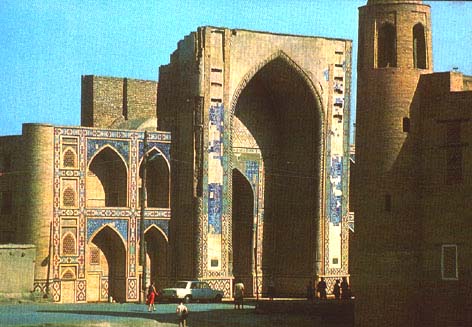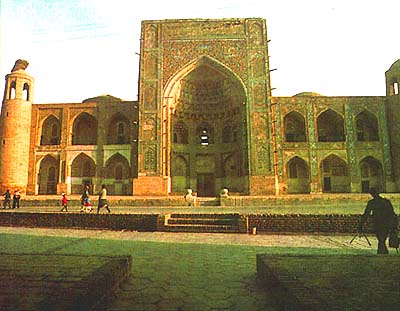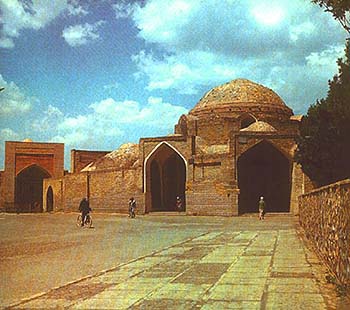Beyond the bazaar, still on Kommunarov, there is
another impressive kosh ensemble. The Ulug Bek madrasa (1417) on the left
(north) is the oldest in Central Asia, and was the prototype for the synonymous
and much more extravagant one built three years later  in
Samarkand. 'To strive for knowledge is the duty of each Muslim man and
Muslim woman,' says the-for Ulug-Bek-typically enlightened inscription
over the entrance. The architect, Ismail ibn Takhir ibn Makhmud Isfagani,
was probably related to an Iranian captured by Tamerlane to work in Samarkand
and Shakhrisabz. It is not usually possible to go inside, but the proportions
and decoration of the facade, including the ceramic plaiting on its main
lancet arch, contain much that was later associated with the 16th- century
in
Samarkand. 'To strive for knowledge is the duty of each Muslim man and
Muslim woman,' says the-for Ulug-Bek-typically enlightened inscription
over the entrance. The architect, Ismail ibn Takhir ibn Makhmud Isfagani,
was probably related to an Iranian captured by Tamerlane to work in Samarkand
and Shakhrisabz. It is not usually possible to go inside, but the proportions
and decoration of the facade, including the ceramic plaiting on its main
lancet arch, contain much that was later associated with the 16th- century
'Bukhara school' of architecture.
 The Abdulaziz Khan madrasa (1651-2) faces the older one across
the narrow street as if, says the Soviet guidebook hopefully, in dialogue.
It is the newest big madrasa in Bukhara and was never quite finished, more
cells being built according to demand. These were relatively cushy; split-level
studios with fireplaces and large storage niches for clothes and bedding.
Students usually rented them for their whole period of study. When numbers
fell the madrasa was used as a caravanserai.
The Abdulaziz Khan madrasa (1651-2) faces the older one across
the narrow street as if, says the Soviet guidebook hopefully, in dialogue.
It is the newest big madrasa in Bukhara and was never quite finished, more
cells being built according to demand. These were relatively cushy; split-level
studios with fireplaces and large storage niches for clothes and bedding.
Students usually rented them for their whole period of study. When numbers
fell the madrasa was used as a caravanserai.
The phoenixes and snake-headed birds in the pishtaks mosaics
represent a brave break with the Islamictradition of not depicting animal
life. (Two other well-known porticoes which break the rule-those of the
nearby Nadir Divanbegi madrasa and Samarkand's Sher Dor madrasa-are also
mid - 17th century.) The rebellion did not catch on and, according to one
Soviet guidebook, may even have been fatal for
this artist. Inside, frescoes of stylized landscapes betraying  Chinese
and Moghul Indian influence survive in the large ex-lecture hall, which
now sells carpets, on the left. The red clay patterns on the roof and niches
were originally dusted with gold; the cracks are from a 1976 earthquake.
To the right of the entrance a former mosque now has a small exhibition
of Bukharan woodwork.
Chinese
and Moghul Indian influence survive in the large ex-lecture hall, which
now sells carpets, on the left. The red clay patterns on the roof and niches
were originally dusted with gold; the cracks are from a 1976 earthquake.
To the right of the entrance a former mosque now has a small exhibition
of Bukharan woodwork.
Return to Taq-i-Zargaran. Beneath the empty plot on the
left are the foundations of an Indian caravanserai. Turn left (south) down
ex-Ulitsa Frunze, and you pass on the left Tim Abdullahkhan (Abdullah Khan
market). Single-entrance domed arcades like this used to line the whole
street. This sole survivor is now a state silk shop.
A little further down on the left an ancient frontage
with steps to a raised entrance has been rebuilt in yellowish brick. Males
should go in. Soap, shampoo, back-scrubber, basin, towel, locker and tea
afterwards costs about 5 cents in rubles in Central Asia's oldest (16th
- century) working public baths, though as a foreigner you may be amiably
overcharged. The only light in the series of semi-subterranean stone caverns
is natural and dim, filtering down from tiny skylights through the steam.
You fill your basin to wash, then sit around on stone benches using the
place as a mild sauna. The barber in the entrance can give directions to
the nearby women's baths.
 Ulitsa
Frunze now disappears into the twelve-sided Taq-i-Telpaq Furushon, the
cap-makers' bazaar. Astrakhan hats and gold-embroidered skull caps are
sold here as they have been since the 16th century. The main dome is lower
but wider than at Taq-i-Zargaron, spanning the junction of five streets.
Ulitsa
Frunze now disappears into the twelve-sided Taq-i-Telpaq Furushon, the
cap-makers' bazaar. Astrakhan hats and gold-embroidered skull caps are
sold here as they have been since the 16th century. The main dome is lower
but wider than at Taq-i-Zargaron, spanning the junction of five streets.
The Magok-i-Kurpa mosque (1636-7), facing the bazaar's
south-west corner, is unusual in having prayer halls on two floors, but
is usually closed to visitors.
Ulitsa Pushkina leads past the mosque, round the bazaar
and along the top of a shady square whose west side consists of a row of
jewellery and antique stalls which will diddle the dozy but may interest
coin collectors. Round the square's south-west corner the 19th-century
building which housed Central Asia's first Russian bank is now an art museum
(closed Tues).
[back]

